Menu



Did you know that China grows over 94% of mushrooms worldwide?
Many customers ask us why we source all our mushrooms from China.
The answer is simple.
It is not possible to produce organic mushroom extract powders in North America.
While it is possible to cultivate mushrooms in North America for food, you'll discover that it is too expensive to grow them at scale for supplement use.
To demonstrate this, I will use shiitake mushrooms as an example since they are one of the most inexpensive mushrooms to grow.
The 2019-2022 USDA average price for fresh mushrooms was $3.50 per pound. This equates to $7.70 per kilo.
So, a U.S. grower receives $7.70 per kilo for fresh, non-organic shiitake mushrooms.
Dried mushrooms sold for supplements will need to be converted to a dried price since mushrooms prefer a slightly different process when used for supplements.
Mushrooms are generally around 90% water, so when shiitake mushrooms are dried, they yield ~10% of their initial weight.
This means that for the grower to get the equivalent of $7.70 per kilo fresh, they will need to charge $77 per kilo dried. (1kg fresh = 100g dried. 100g * $77/dried kg = $7.70)
This is where the economics of mushroom farming start to break down.
To produce a simple extract, the dried mushrooms must be ground into a powder, extracted with hot water and/or alcohol, concentrated and then converted from a liquid into the final extract powder. Then, testing and quality control would be required to ensure the ingredient is safe for consumption. This can easily add upwards of $50 per kilo in equipment and labor.
$127 per kilo for a 1:1 shiitake mushroom extract powder, with no additional profit margins added yet. This is already too expensive for the majority of supplement companies.
This is for non-organic and one of the cheapest functional mushrooms.
Certified organic mushrooms are more expensive, and harder-to-grow mushrooms like reishi can easily double their price.
Now, for an 8:1 extract like in our Turkey Tail product, 8 times the mushrooms are needed before processing begins, so the raw ingredients costs would be $616+ per kilo. This would not be competitive in the current functional mushroom supplement marketplace, which is why you cannot find it.
A 16:1 reishi dual extract, like in our 5 Defenders Organic Mushroom Blend, would cost over $1200 per kilo in dried mushrooms grown in North America—be it wild mushrooms or cultivated varieties. To consider high-cost specialty supplements, such as oyster mushrooms or brown mushrooms grown for niche markets, would compound these expenses further.
This is why mushrooms are not grown for supplements in North America.
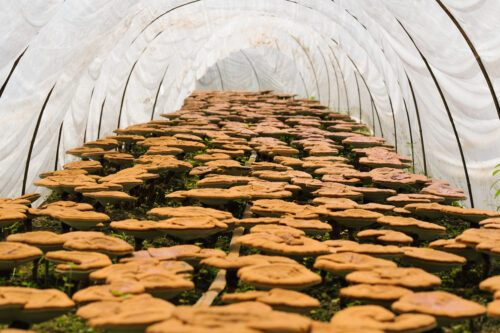
If this is hard to believe, here's what the USDA says.
The U.S. Department of Agriculture releases reports every year on the production and sales of various agricultural crops, including mushrooms.
They break it down into location, mushroom type, organic, etc.
Some interesting facts from their 2019-2022:
If we want to consider edible mushrooms used for supplements, we focus on specialty mushrooms like shiitake or oyster mushrooms, which account for a small fraction of production.
The table below breaks down the total production for 2021/2022:
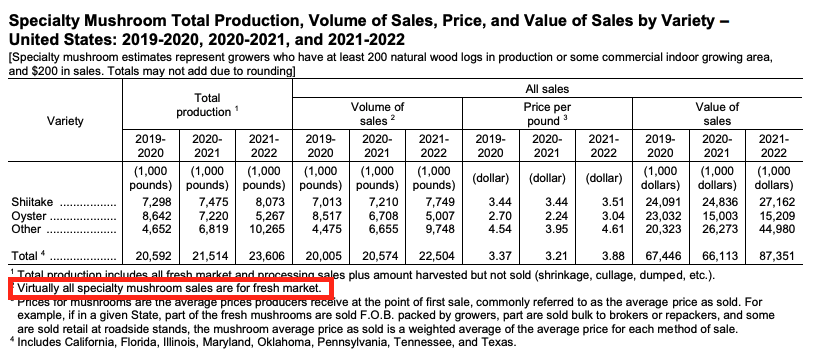
Specialty mushroom estimates represent growers with at least 200 natural wood logs in production or some commercial indoor growing area and $200 in sales.
While the U.S. grew 23 million pounds of specialty mushrooms, footnote #3 says: "Virtually all specialty mushroom sales are for fresh market."
The USDA says that no specialty mushrooms are being grown or used by anything other than the fresh market (i.e., None of these mushrooms are being used for supplements).
This confirms the statements above about it being too expensive to grow functional mushrooms for use in supplements in the U.S. or North America, for that matter.
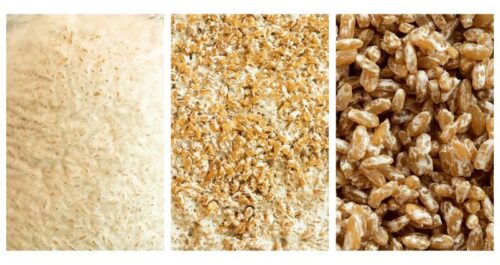
A solid mass of myceliated grain, or mycelium biomass, shown as a fully grown block, but when broken apart, it reveals itself to be mostly grain.
But you can find so-called functional "mushroom" supplements claiming to be US-grown.
Functional mushroom supplements and ingredients that claim to be "US Grown" almost always do not contain mushrooms. As you've seen above, they are too expensive.
But if it's too expensive to grow them, what is it?
Mycelium, combined with decaying organic matter such as raw grain, is grown and consumed following a drying process. The result is mushroom mycelium supplements that are cheaper and widely available, even though they may not deliver the same robust properties as whole mushroom extracts.
The main suppliers of U.S Grown "mushroom" ingredients are actually selling myceliated grain and not mushrooms. You will recognize this product as grain spawn if you're a mushroom grower. It is the seed used to start the process of growing mushrooms.
Myceliated grain is sterilized grain that has been inoculated with the mycelium of a fungal species like shiitake, reishi, lion's mane, turkey tail, etc. The shiitake mycelium will then begin to grow out on the grain, and in 30-60 days, it will be dried, powdered and sold as a "mushroom" ingredient grain even though it contains no mushrooms.
It is very cheap to produce and economical for supplement use.
Here's an example of the full process from start to finish, and you can read further on how to identify myceliated grain.
China is the leading mushroom farm worldwide, accounting for over 94% of production as of 2022 [2]. Their mushroom production has increased around 40 times in the last 30 years.
China is now commercially cultivating more than 60 different mushroom species. These include wood ear, shiitake, and oyster mushrooms, which are often grown using wood chips as their substrate.
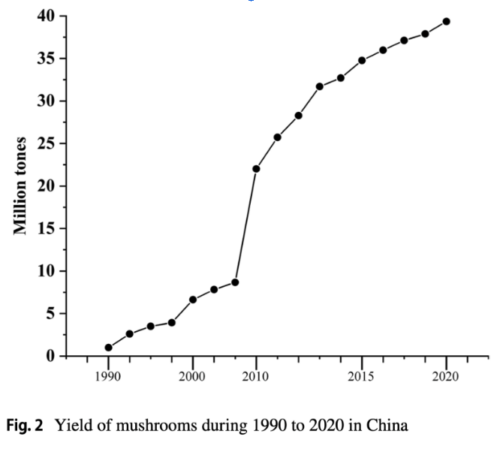
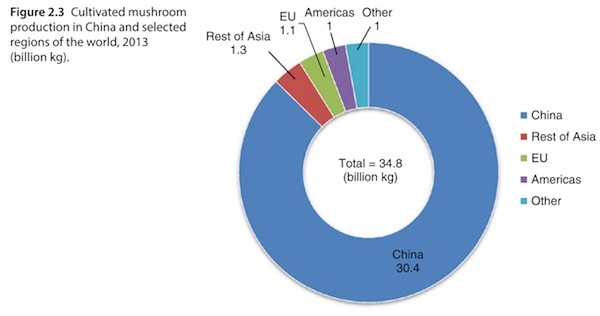
Shiitake (lentinula), Wood ear (auricularia) and Oyster mushroom (pleurotus) have all pushed ahead of the button mushroom (agaricus) in global production.
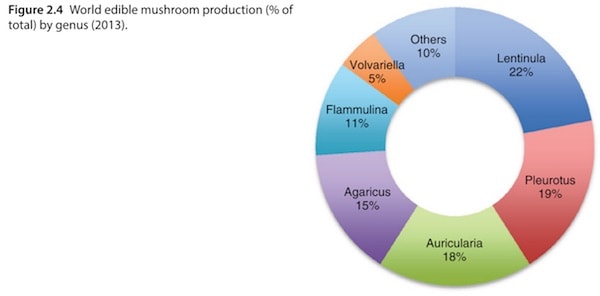
China has a rich history of mushrooms. They have been a food source used in traditional Chinese medicine for hundreds, if not thousands, of years. China was the first to begin cultivating mushrooms in the early 13th century. They have more researchers than anywhere else in the world and many research centers are dedicated solely to the development of mushrooms, whether as food or as medicine.
China has only recently increased its consumption of mushrooms. As production has increased, so has consumption. In 2005, per capita consumption was only 0.5kg per year. In 2021, it is now 63.82kg. In comparison, Americans eat roughly 1.36kg of mushrooms per year, around 47 times less than China. A Chinese person will eat more mushrooms in less than 2 weeks than an American will eat in a year.
Mushroom growing is a big business in China. It has become one of their top agricultural ventures, employing modern technology and nationwide strategies to grow mushrooms efficiently. Farmers use highly adaptable techniques to help boost mushroom growth, such as using growing mediums made from decaying organic matter like wood chips.
China now uses mushroom production to help local communities out of poverty. Mushroom farmers earn 10 times more than rice or corn. Li Yu, a noted mycologist and an academician of the Chinese Academy of Engineering, has been a champion of using mushroom growing to alleviate poverty.
Every year, when I travel to China during the mushroom harvest season and visit the organic mushroom farms, I eat many different kinds of mushrooms. There is not a single meal that goes by without some kind of mushroom dish. Whether at an enormous mushroom farm or a smaller community, I always see the same quality standards upheld.
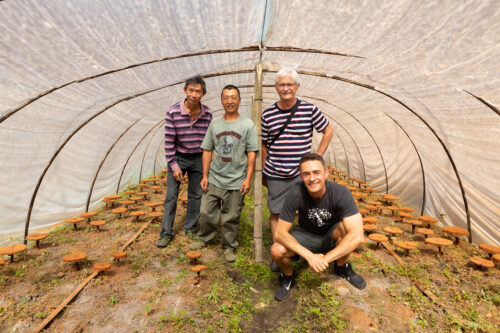
Our mushroom extracts come from Nammex, the leader in organic mushroom extracts. They supply some of the biggest companies in the world with mushroom ingredients.
All of our extracts are tested multiple times for heavy metals, pesticides, and microorganisms: once in China, again when they arrive in the US, and a third time after it goes into the finished packaging.
The “Consumer Reports” of supplements, ConsumerLab, has chosen Real Mushrooms as their top supplement for the last 3 years. They are authorities in independent testing for supplement quality.
It's important to understand that while it is possible to grow mushrooms in North America for food or very small-scale DIY supplements or tinctures, economically speaking, it's too expensive to grow certified organic mushrooms for dry extract powders at scale. “At scale” is the key here. This is the entire reason why companies grow myceliated grain in the US and sell them as mushrooms instead. US-grown myceliated grain is a lot cheaper than organic mushroom extract powders from China.
The workers at the farms our supplier, Nammex, partners with are treated very fairly and have a great quality of life. One of our missions is to raise awareness and educate consumers that not all products from China are inherently harmful. Rest assured that we would never support any farms that practice harmful treatment of their workers.
For functional mushrooms, China is the leading grower worldwide, and no other country comes close to its production volume. For this reason, if you want mushroom extract made from the mushroom, it must come from China.
Growing mushrooms in North America is too expensive for supplement use. The only option is laboratory-grown myceliated grain because it is much cheaper. However, myceliated grain is not mushrooms and should not be marketed as edible mushrooms when it does not contain any, and most of it is grain.
When selecting a functional mushroom product, it is important that it is:
 .
.Disclaimer: The information or products mentioned in this article are provided as information resources only, and are not to be used or relied on to diagnose, treat, cure, or prevent any disease. This information does not create any patient-doctor relationship, and should not be used as a substitute for professional diagnosis and treatment. The information is intended for health care professionals only. The statements made in this article have not been evaluated by the Food and Drug Administration. Any products mentioned are not intended to diagnose, treat, cure, or prevent any disease. The information in this article is intended for educational purposes. The information is not intended to replace medical advice offered by licensed medical physicians. Please consult your doctor or health practitioner for any medical advice.